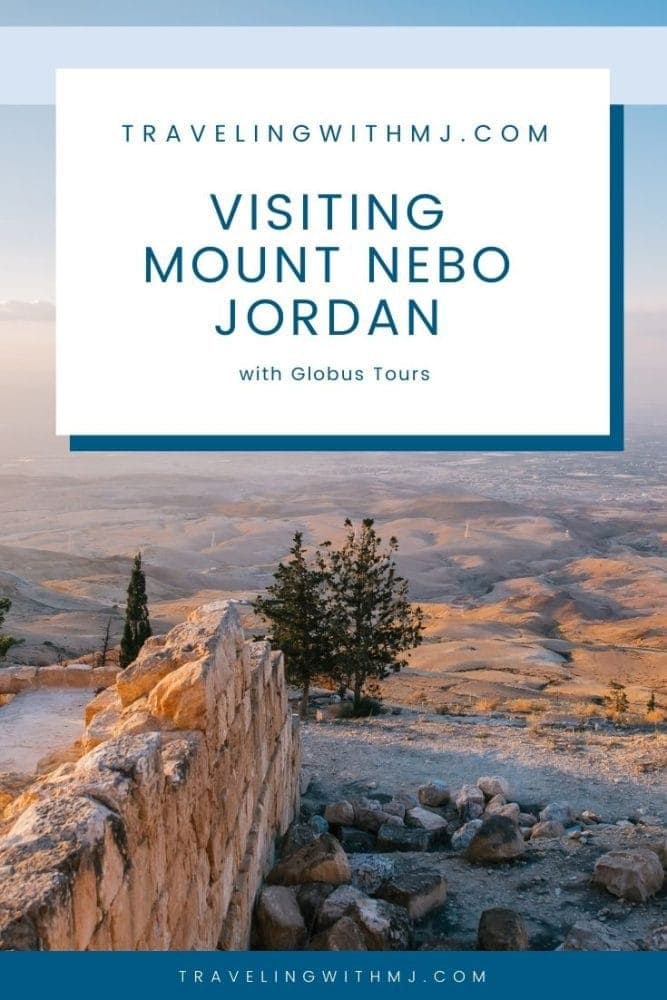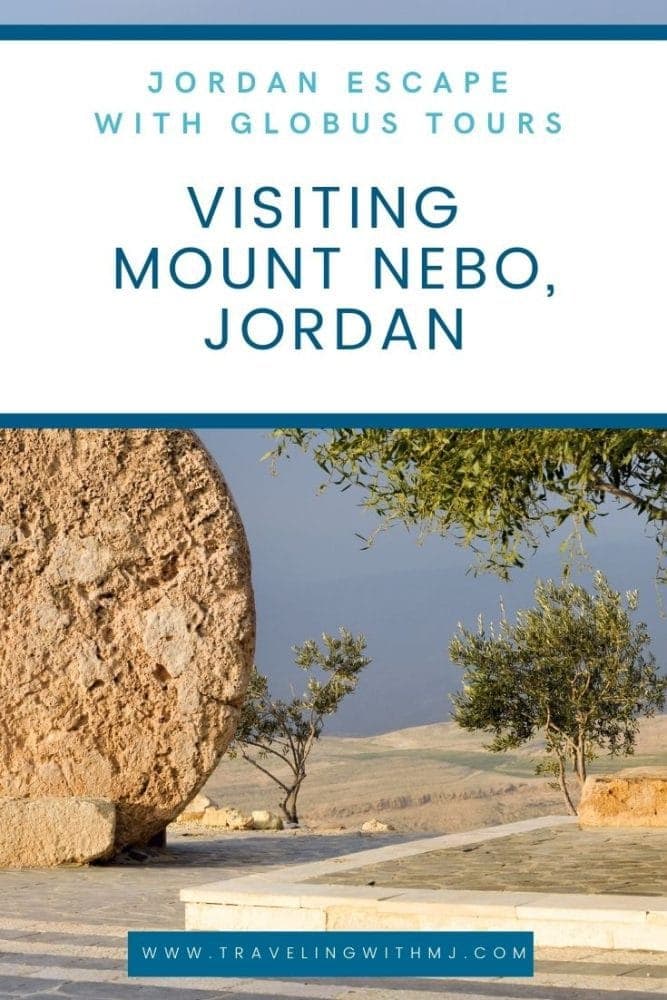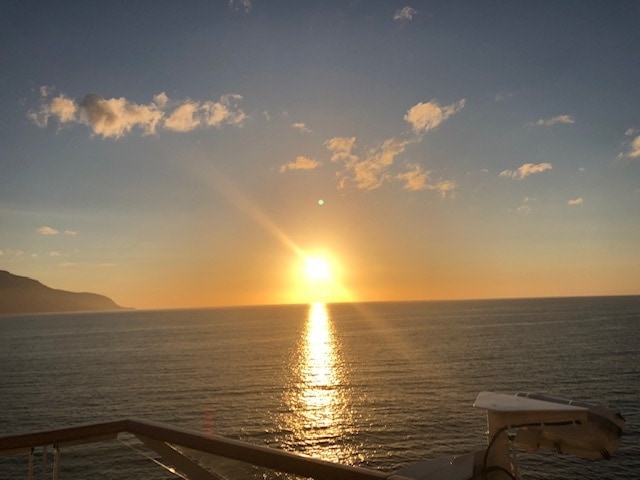Mount Nebo is a lesser-known, but still a very important historical landmark in Jordan. The mountain has a major biblical significance to the people of Jordan and Israel as the religious site is said to be the place where Moses looked towards The Promised Land before he died upon the mountain top.
Mount Nebo is an important stop on a visit to Jordan and I was glad to see it on my itinerary. With views overlooking the Dead Sea, Jeremiah, and even Jerusalem, this important historical site is also an area of outstanding natural beauty.
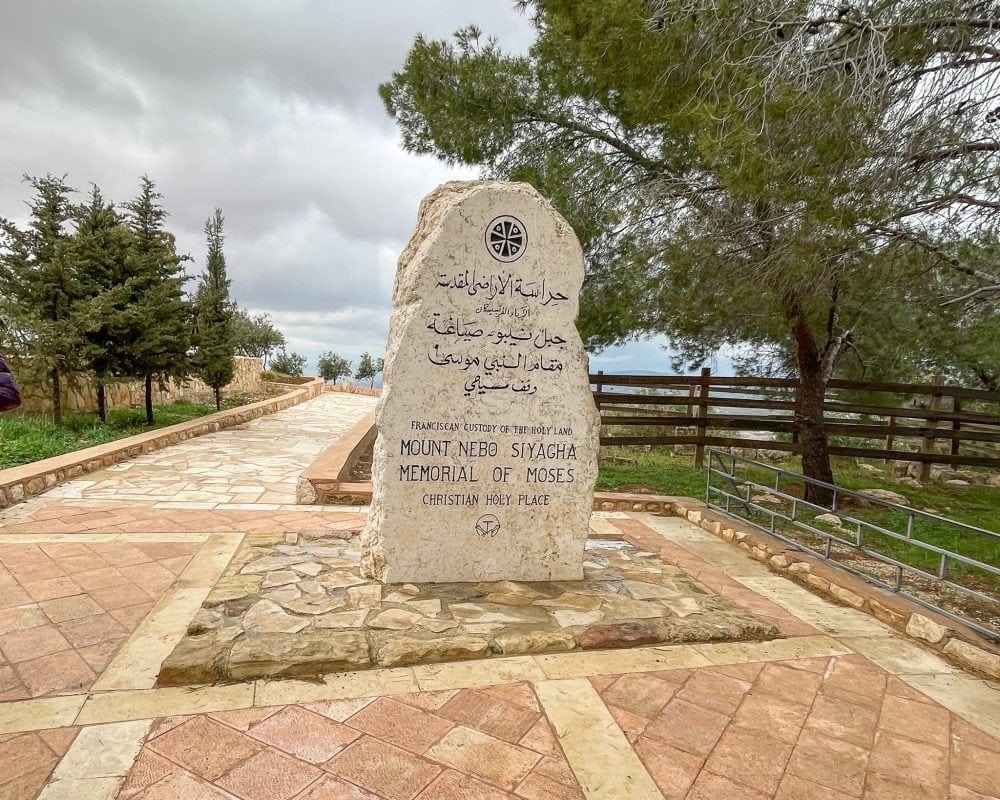
Though today the mountain peak is a tourist attraction with an admission fee, the religious connections are felt by most who visit here. It is a popular pilgrimage site for many religious devotees, and even though I don’t consider myself a religious person, I couldn’t help but be swept up in the history of the site and the poignancy of being there. While visiting, I felt a sacredness about the site. Call it religious, spiritual, or reverence, it just felt special.
I visited Jordan as part of a paid partnership project with Globus Journeys. I previously toured with Globus on their California Dream’: Northern California by Design tour and was impressed. I loved their attention to detail, the quality of their itineraries and guides, and the enjoyable environment they created among group members. Saying yes to the Jordan Escape tour was easy-peasy.
Our Jordan Escape tour started in Amman and during our seven days together, we saw more than I had imagined would be possible. The itinerary included: Amman, Jerash, Wadi Rum, Petra, Mount Nebo, Madaba, and Bethany Beyond the Jordan. While this post covers some information about visiting Mount Nebo, you can expect some additional posts covering some of the other Jordan highlights.
I think it’s important to talk about group trips. Some of you may think of me as more of an independent traveler. And while that’s true sometimes, there are also times when I want things handled for me. There’s something freeing about having someone else makes all the plans and take care of the details. No arguments over where to go for dinner (come on, am I the only one who has had that conversation go on long past dinner time and into the hangry zone?). It’s nice not to have to track and coordinate opening hours and fees and is really nice not to worry about toting luggage around. All of those details become more complicated and time-consuming when you’re visiting an international destination where things are different than the way you’ve “always done things” at home.
Jordan is a destination with a complicated history. It’s full of incredible historical sites that date so far back that it made my head spin. It has amazing natural sites that made my jaw drop. And it has warm, friendly people who are eager to share their hospitality – and their smiles – with you. A Globus tour strips away all the complicated stuff of travel, leaving you with the parts that light up your eyes as you enjoy another amazing day. And there were lots of amazing days in Jordan.
So let’s learn about Mount Nebo.
[toc]
Getting to Mount Nebo?
Mount Nebo is located about 6 miles northwest of Madaba (10-minute drive) in the Hashemite Kingdom of Jordan, just a short distance from the Jordan/Israel border. The mountain is part of the Abarim mountain range and is approximately 2,631 feet high. Mount Nebo’s peak, also known as Siyagha, is where the religious sites are located. The town of al-Mukhayyat, known as the town of Nebo, is just about two miles away.
Another great aspect of being on a Globus tour is not having to navigate distance and travel time and leaving the driving to someone else. Plus, you’ll stop at Bethany Beyond the Jordan, a UNESCO World Heritage site, where John the Baptist baptized Jesus in the Jordan River.
The entrance fee to Mount Nebo is 2 JD (Jordanian Dinar), about $3 at the current exchange rate. Again, this is something that I didn’t have to think about as it was covered by the tour.
The biblical site is located at the top of the mountain. Don’t worry, the walk is easy (says this overweight middle-aged woman). The road takes you most of the way up the mountain, and once you are through the entrance, you walk a short distance along a stone path to the site. The weather was cool when we were there, turning a bit rainy after a while, but olive trees line the path to provide shade in warmer weather.
From the top of the mountain, you can see views over Israel, the Dead Sea, Jericho, the Jordan River, and the West Bank. On a clear day, you can even see as far as Jerusalem.
History of Mount Nebo
Mount Nebo is one of the most important biblical sites for the three major religions; Judaism, Christianity, and Islam. According to the Old Testament, Mount Nebo is the place where Moses lived out his final days and saw the Promised Land (now known as Israel), where God told him he would never visit before he died. Because of this significance, Mount Nebo is a popular spot for religious travelers who, like Moses, want to witness the same views of the Promised Land below.
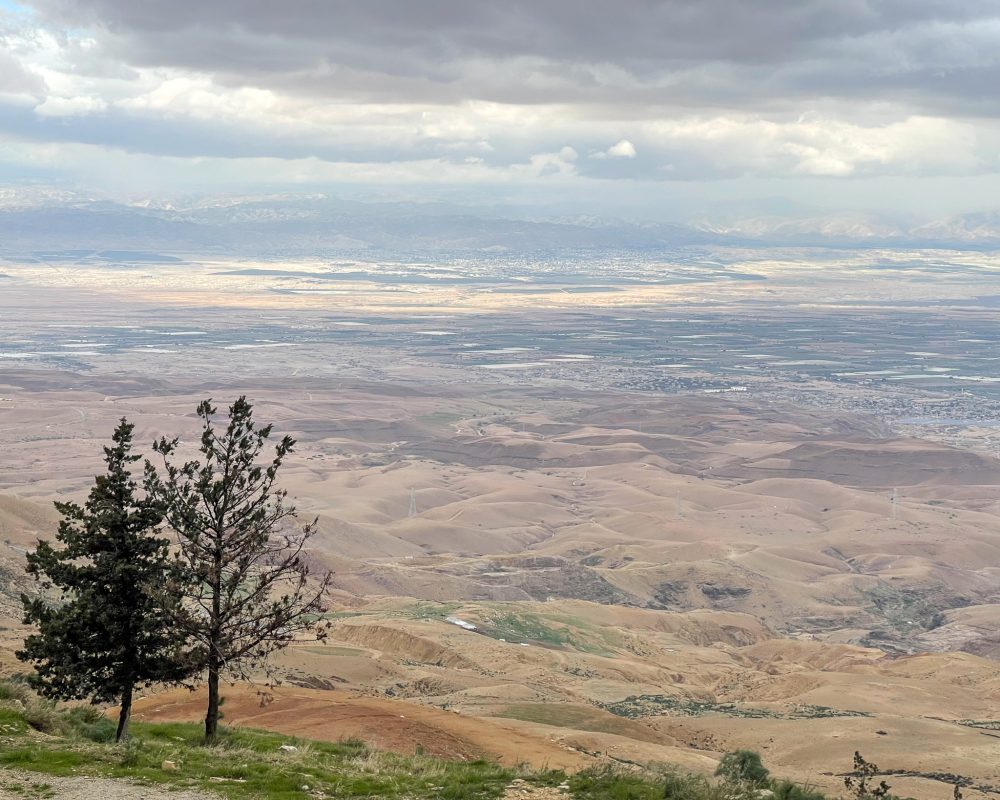
Since the 4th century AD, the mountain has been a pilgrimage site. During this time, a church and sanctuary were built on the highest peak, Siyagha, to honor Moses. Two years later during the 6th century AD Byzantine era, monks expanded the church into a monastery that stood for almost 600 years before crumbling into decay.
It wasn’t until 1933 when the site was bought by the Franciscans that the site was redeveloped. Between 1933-1938, a Franciscan named Sylvester Saller excavated the site, where he found the basilica with its chapels, along with the annexes of the monastery. He also discovered mosaics along the chapel walls and floors. According to the signature next to the inscription, the original mosaics were created by Soelos, Kaiomos, and Elias during the time of Bishop Elias in the year 530 AD. The mosaics show a scene of hunters, farmers, and animals among ornate trees and flowers on a white background, framed by an ornate, chain-style border.
During the excavation of the church, six tombs were also discovered in the hollowed rock beneath the mosaic floor. The tombs were unmarked, so it is unknown who they belong to. After the excavation, the mosaics and tombs were covered with soil to protect them. The mosaics were brought back to light in 1963 when the Custody of the Holy Land decided to restore the mosaic floors and build a memorial church around them.
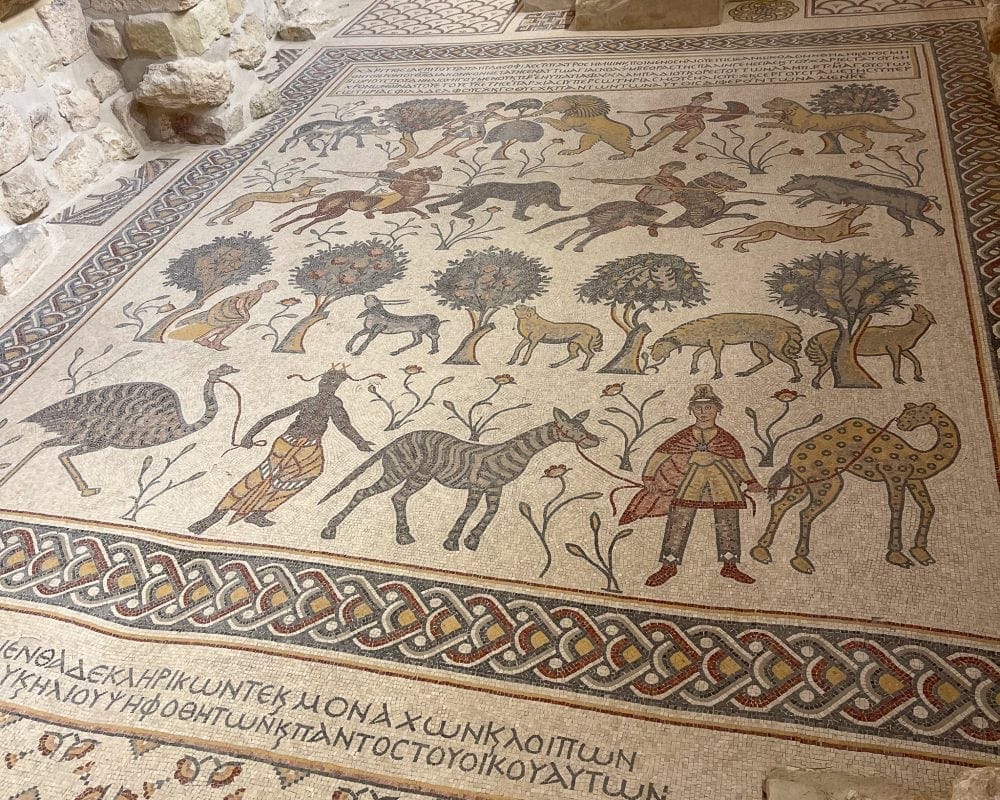
Work on the restoration was interrupted by the 1967 Arab-Israeli war. When it began, workers found a new mosaic in the Diaconicon, an Orthodox Christian term used to describe a chamber where vestments, books, and religious objects are kept. In 1984 work was completed on the restoration of the mosaics, and a new memorial basilica was built for liturgical purposes, as well as for displaying the restored mosaics, both on the floor and the walls of the inner chamber.
Between December 2007 and October 2016, a new church, the Moses Memorial Church, was built over the original ancient one, which provides better protection for the mosaics. Today, only the original mosaics remain of the original church, which has been lovingly restored to near immaculate condition. Next to the Moses Memorial Church, there is an olive tree that was planted by Pope John Paul II, who visited the site on his pilgrimage to the Holy Land in March 2000. The olive tree was planted by the Pope as a symbol of peace.
In 2009, Pope Benedict XVI also visited the site as part of a pilgrimage. While there, he congratulated King Abdullah II on his 10th anniversary as ruler, continuing to foster good relationships between Christians and Muslims.
Also in the religious site of Mount Nebo, situated near a lookout platform over Israel, there is a serpentine cross sculpture created by Italian artist Giovanni Fantoni. It is called the Brazen Serpent Monument. The sculpture is of a bronze serpent enterlacing the Holy Cross, which is also made out of bronze.
Why a serpent and cross?
The Old Testament (Numbers 21, 5-9) says that to punish people for their lack of faith, God sent snakes to eat their livestock and crops. Moses created a bronze serpent on a rod, which was used to cure anyone bitten by snakes. The serpent has become a symbol of Moses and of salvation, and the cross symbolizes the crucifixion.
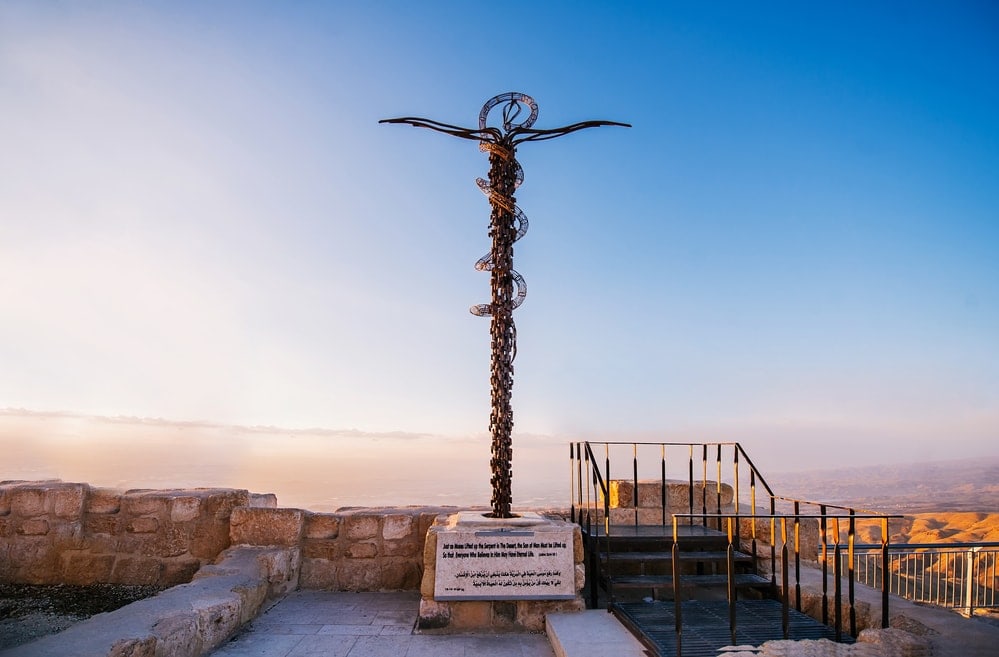
There are all sorts of biblical and historical theories surrounding Mount Nebo, some reasonably based in history and others more speculative or fantasy-related.
It’s been speculated that Moses’ body may be buried on the mountain peak. While this is certainly a possibility given the history and artifacts found on the top of Mount Nebo, it remains a theory that has never been proven.
Legend also has it that The Ark of the Covenant, a chest made for the original tablets of the Ten Commandments that were engraved by God for Moses, is buried in a cave on Mount Nebo. In the Book of Maccabees (2 Maccabees 2:7), it states that the Prophet Jeremiah hid the ark in a “place [that] shall remain unknown until God gathers his people together again and shows his mercy.”
There have been all sorts of theories about where the Ark might be found. Movies and books are rife with theories about the exact location of the Ark. Hollywood based the movie Indiana Jones and the Last Crusade around one theory, adding in a little literary license for good measure. There’s also some evidence that the Nazis chasing the Ark theme has some basis in fact. But, the Ark has not been found on Mount Nebo.
What Do I Need To Know About Visiting Jordan and Mount Nebo?
The simple answer is just to go. On my Globus tour, we did it as part of a Dead Sea day trip. That provides us with a local guide who was an expert in the history of the area (Globus really shines at having knowledgeable local guides for all their tours), was familiar with biblical texts that talked about the area, and was able to weave history into compelling storytelling.
Here are some additional tips:
Is Mount Nebo worth visiting?
Even if you are not religious, Mount Nebo is a site that has much significance. It was one of the places friends were most interested in (beyond the basics of Petra and Wadi Rum) when I said I was traveling to Jordan. I confess to having only a cursory knowledge of the site, but did a little reading (recommendations on that below) and was excited about visiting.
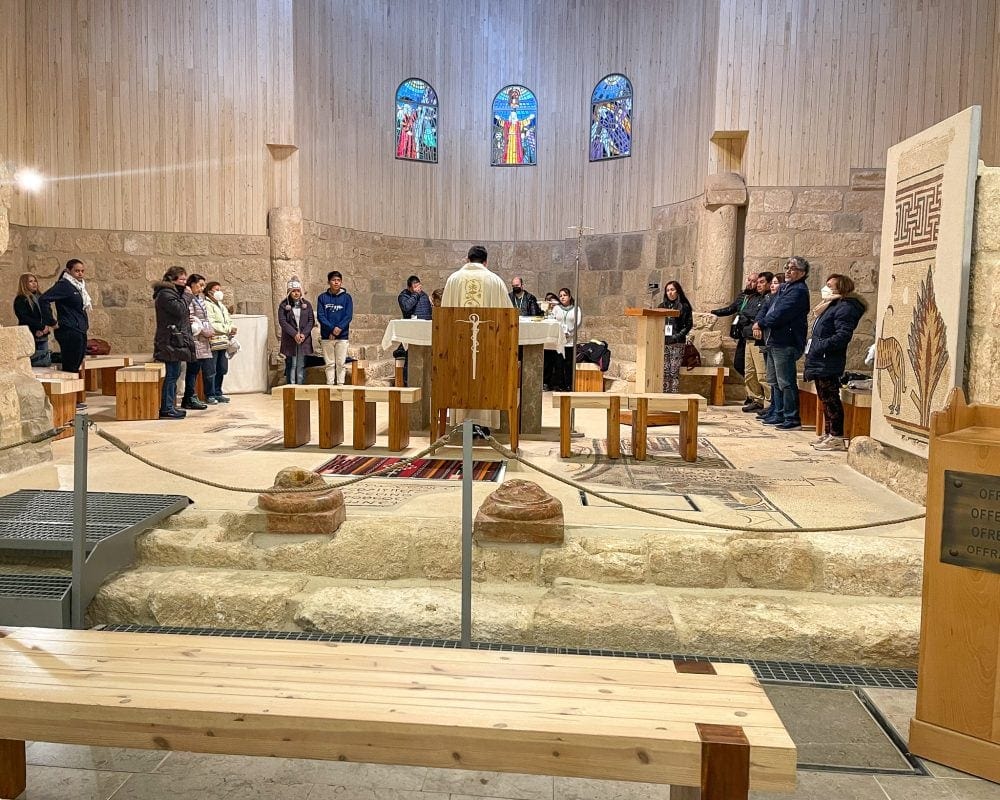
Although I don’t strongly identify with any religion, visiting Mt Nebo and the biblical sites in Jordan was one of the best things about the trip. And don’t forget, the site offers a great view of the Promised Land (Israel) and the valley of the River Jordan.
Why is Mount Nebo important?
Mount Nebo is important because it is said to be the last known place of Moses before he died. It has been a pilgrimage site for many people and is a sacred location for three major religions.
Where is The Promised Land today?
In the Bible, The Promised Land refers to Canaan, which is today known as Israel.
Is it safe to visit Jordan?
I heard this question a lot after I shared that I was going to visit Jordan. While no place is 100% safe these days (whether because of Covid, local issues, or violence), I didn’t hesitate for one second to say yes to the invitation to go to Jordan. I think the question comes from a lack of understanding of the Middle East, predominantly Muslim countries, and a more general fear of destinations that may not be just like us.
One of the great things about traveling with Globus for your tour of Jordan is that they take care of precautions and details so you don’t have to. For a first trip to Jordan, I recommend them highly. And, of course, use a little common sense about leaving valuables at home, watching your personal items, and maintaining situational awareness. It’s the stuff you should be doing whenever you travel anywhere, even at home.
While there clearly has been unrest in the Middle East – spanning decades – the Mount Nebo site, along with all the other stops on the itinerary, are not near areas of conflict (as exists along the border with Syria). While I haven’t traveled extensively in the Middle East, I have visited Israel and the Palestinian Territories, in addition to Jordan, and felt perfectly safe and comfortable in the locations. Because of the requirement for compulsory military service, it is common to see a strong military presence on the street with lots of young faces. This is not a bad thing.
What is it like traveling in a predominantly Muslim country?
Since 9/11, this question is inevitable.
Jordan’s population is about 93% Muslim, overwhelmingly Sunni, and about 6% Christian. You will see mosques dot the skyline, with speakers for the calls to prayer. Residents are clothed in all manner of dress, including western garb and jeans and t-shirts Women are not required to cover, although you will see women in hijabs and burqas. You will also see some men wearing a keffiyeh, a traditional scarf (often a red and white fabric) wrapped around the head and secured with an igal (black headband).
When visiting, I’d recommend wearing what you would at home, leaving behind anything too skimpy or revealing. When visiting holy sites, having shoulders and knees covered is respectful and advised. I wore jeans and t-shirts most of the time when out touring and fit right in.
Were the people nice?
To be honest, the question is more usually asked in the negative, as if somehow religious differences changed my interaction with locals. Nothing could be further from the truth.
In all my activities while in Jordan, the local Jordanians were warm and welcoming. If there was ever a reminder that personal interaction is different from governmental interactions, you’ll discover it in Jordan. I firmly believe that if more people visited places that weren’t “just like us” the world would be a better place.
Recommended Reading
A Globus friend recommended The Book of Longings last year, and I just got around to reading it earlier this year. It’s an excellent book and had much relevance to the holy sites in Jordan (and beyond).
I also recommend Leap of Faith by Queen Noor for a general overview of Jordan. It provides an interesting look at the country through a western lens (the Queen was an American prior to her marriage).
Final Thoughts on Visiting Mount Nebo
Whether you’re visiting on a pilgrimage or just interested in learning about some of Jordan’s most unique and significant history, Mount Nebo is definitely worth your time. The site is not huge and we were there for about an hour(ish). Even though a relatively short amount of time, it remains some of the most significant time that I’ve spent anywhere.
It seemed like every day of my Globus tour brought a smile to my face – I can’t believe the number of times I said, “this is a great day.”
For Pinterest
Save to your favorite travel boards and start planning for your Jordan Escape
